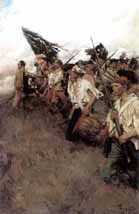The
American Revolutionary War: Keeping
Independence
Part 3: The End and the Beginning It was supposed to be a great British victory, resulting in the seizure of all of New York. British forces, under three generals, would converge on Saratoga and trap the American forces there, forcing them to surrender. Instead, only one British general showed up at Saratoga, General John Burgoyne. He fought anyway but, in the end, had to surrender almost his entire army to American General Horatio Gates (October 1777). This was a stunning development, and the world took notice. In particular, France, always willing to fight against Great Britain, agreed to send money and troops to the Americans.
In the spring of 1778, Washington fought the British to a draw at the Battle of Monmouth. This was considered to be somewhat of a victory. Both sides fought on, in minor battles for the better part of 1779. Then, the focus turned south. The American success at Saratoga and at several skirmishes after that had convinced the British to focus more on the south, where they were having greater success. The British had occupied Savannah, Georgia, in December of 1778. The Americans tried to take it back the next year but failed miserably and suffered heavy casualties. But the American people fought on. In battle after battle in the south, British victories didn't seem to matter. The British won at Charleston and Camden, but the Americans kept retreating but not giving up. Finally, in October of 1780, a breakthrough came at the Battle of Kings Mountain, South Carolina. In just 65 minutes, American forces decidedly defeated the British and captured one-third of the entire southern British army. The Continental Army followed up that success with another smashing victory at Cowpens, South Carolina, the following January. Now, the Americans had the British on the run. A few months later, the British technically won the Battle of Guilford Courthouse (in North Carolina). However, the British lost even more men. With French reinforcements on the way on land and at sea, the British turned north.
They never did. French ships sailed into Yorktown harbor instead, while the American army advanced. Forced into a battle he didn't want, Cornwallis fought anyway. But the combined might of America and France was too much. On October 19, 1781, Cornwallis surrendered his army to American General George Washington. A few details remained. Some minor skirmishes took place, mainly between people who hadn't heard that the war was over. British troops left America while the two sides negotiated the terms of a peace treaty. That treaty came in 1783 and was called the Treaty of Paris. America had won its war of independence. First page > The American Independent Spirit > Page 1, 2, 3 |
|
Social Studies for Kids
copyright 2002–2025
David White

 Even
though Saratoga was a great victory, the British still owned
a lot of territory in America. George Washington was still
fighting for his life in Pennsylvania and New Jersey. Just a
few months after Saratoga, Washington and his troops had to
endure the terrible winter at
Even
though Saratoga was a great victory, the British still owned
a lot of territory in America. George Washington was still
fighting for his life in Pennsylvania and New Jersey. Just a
few months after Saratoga, Washington and his troops had to
endure the terrible winter at  Lord
Lord

